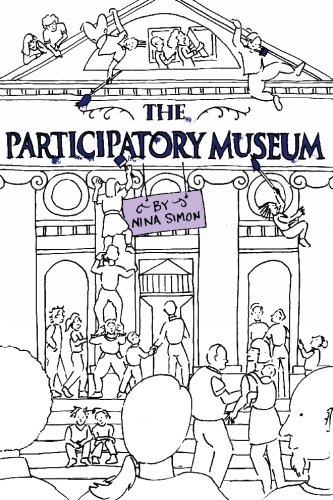I picked this book up because I have an interest in mini-museums and have been brainstorming new museum experiences. I call them “museums” because that’s the closest term I know that describes them. The main difference might be that is that museums are there to tell a story and show you the artifacts of that story but my ideas are more about the experience for the visitors. I should probably call them “experience spaces” or something, but I use the word museum because I have more mental images I can references when brainstorming.

I also was interested in The Participatory Museum because one of the main tools the Eureka Room uses is participation. I don’t want the Eureka Room to be a passive experience for people.
This is a really great book. There’s value from beginning to end and while there’s a lot of words dedicated to explaining concepts and relationships, it manages to keep from the esoteric gobbledygook that museum defenders can fall into, imo.
Nina Simon is an engineer turned experience designer, which I think is why the information is so straightforward and useful. (I also describe myself this way so it’s possible I enjoyed this book so much because we think similarly).
Here’s just a few things I learned that I thought were helpful.
Not Everyone Wants To Be Creative
While a lot of “participatory” stuff centers on the participants making things or being creative, only a small percent of people actually want to do this. This seems obvious if you are not a creative. But if you’re surrounded by creative people (like I am) that want to do this kind of stuff it can be easy to assume the rest of the world loves it, too. Not necessarily.
But, fear not! There are other ways to participate other than creating. There are people who like to give feedback and critique, there are people who like to organize and rank, and there are other types of “participation” that people can do. You can construct ways to participate in these ways that are both valuable to the institution and the visitor. (Read the book to see how).
It’s Not All About You
You need to focus on the needs of your participants, your institution, and your visitors. This concept comes up again and again in so many books I read. It can’t just be about you. It can’t just be about them.
There are different depths of participation you can consider. Simon distinguishes from interacting with content, to creating content, and interacting with other people in the museum. While there’s probably not clear boundaries in real life, these distinctions are real and each type of participation you might attempt does have costs and benefits.
This Book Has Breadth and Depth
I really like that she gets into the nuts and bolts of operations. For example, if your institution is becoming more participatory, how will the front-line workers feel about that? Are they the right people? Can they be trained? Will they resist? How do you make the transition a smooth one? She has many suggestions.
At first glance, I thought the book was going to be a sort of “how to get your visitors to do arts and crafts” but Simon goes way deeper than that. Much of her focus is how to engage a diverse audience, people who don’t think the institution is for “people like them”, and don’t see the value of it.
Getting people to participate is also about making people feel part of the community and getting the institution to support the community. There’s examples of people in the community bringing in items or photos that mean something to them to be displayed for all – and these exhibits becoming more popular than anything the museum had created on its own.
There’s a lot of good information on how to engage with your visitors. What kinds of questions to ask and not ask, how to get the feedback that will be useful to your institution. How to determine what you are asking of the and what you are providing them for their participation.
There’s a lot of short case studies that show how certain ideas worked or didn’t. There’s lots of lessons here that you won’t have to learn the hard way. There’s also lots of ideas you can steal/borrow. Throughout the book you feel what you’re being told isn’t just theory, but the distilled experience of someone who’s been there. In fact, even though the book was written by Simon, it was created online with the help of anyone that wanted to add or comment on drafts. (You can read it for free online, too).
One observation I had was that many of the most well attended participatory exhibits were somewhat unpolished. I wonder if the amount of amateur videos, blogs, and websites we’ve seen over the last two decades has in some ways made such rough around edges content more acceptable. Similarly, we’re at the one year mark for the pandemic and we’ve gotten used to (at least somewhat) seeing celebrities and newscasters producing content from their bedrooms and home offices instead of slick studios filled with laughing live audiences. Things seem more real and equinanimous. I wonder if the doors are opening to a more broader understanding that we’re all just people. But I digress. That’s for another post.
I highly recommend you read this book if you are trying to get more engagement with your institution or just like read books by experts in other domains, like I do.